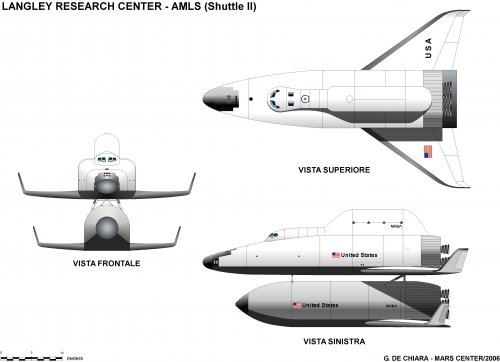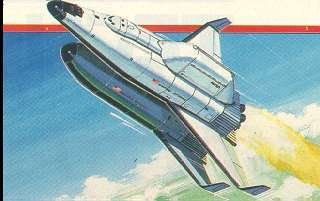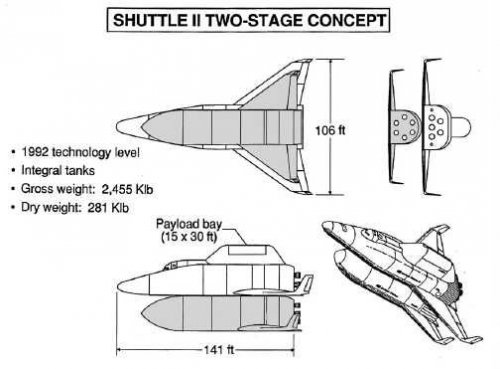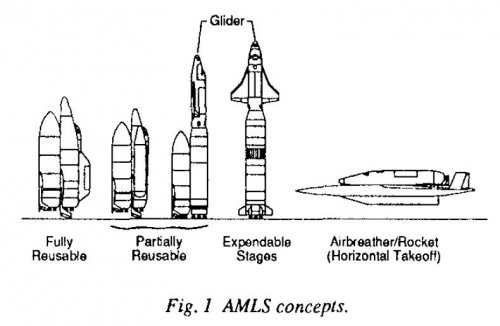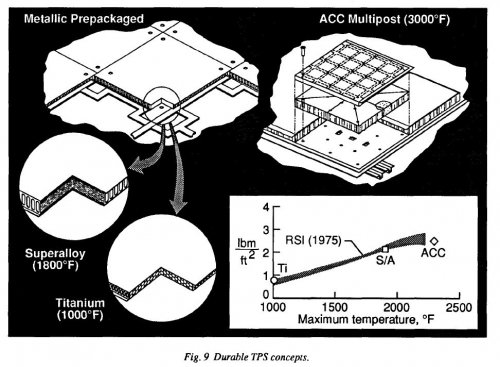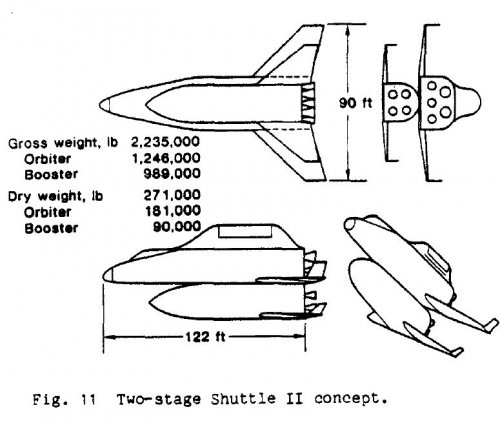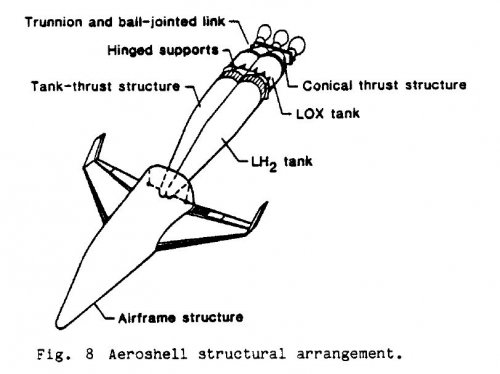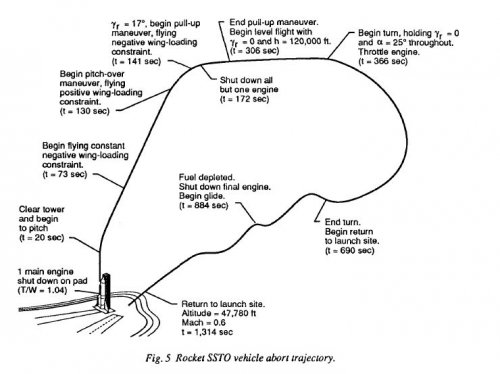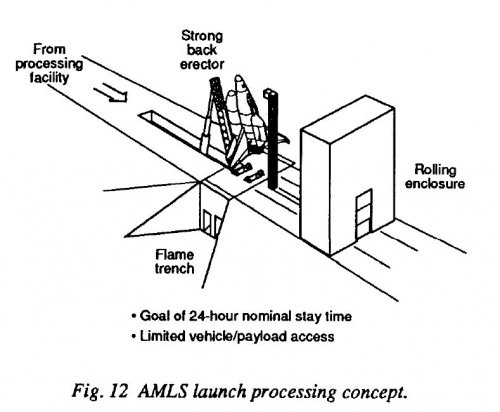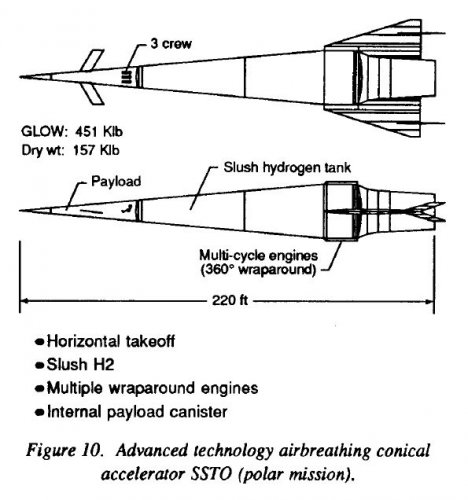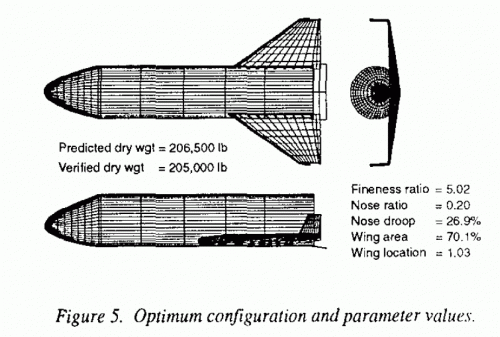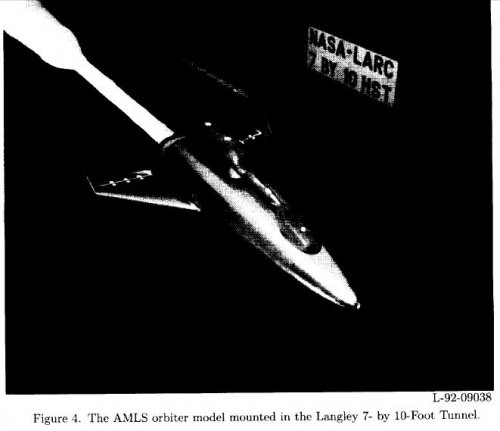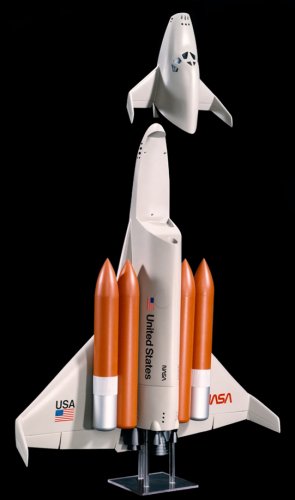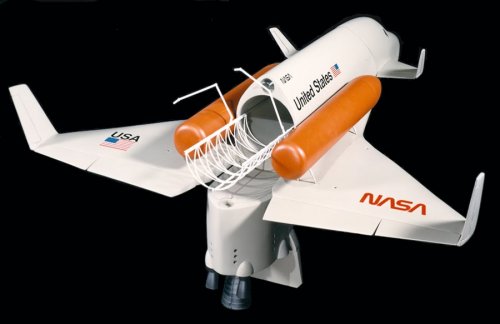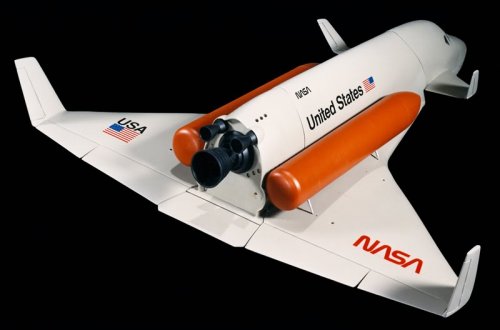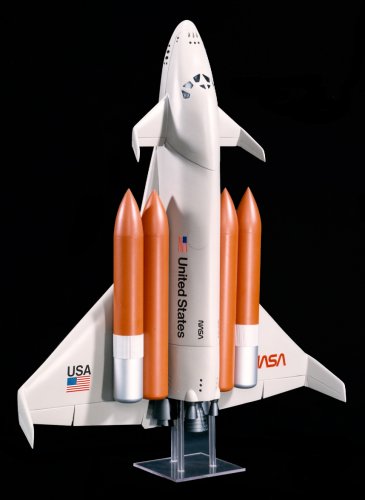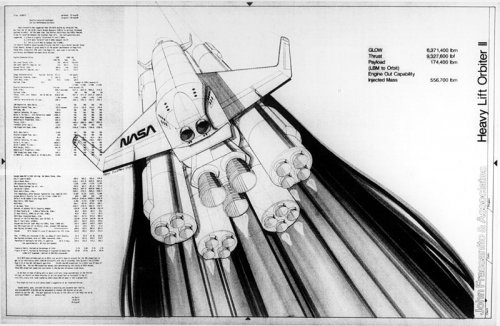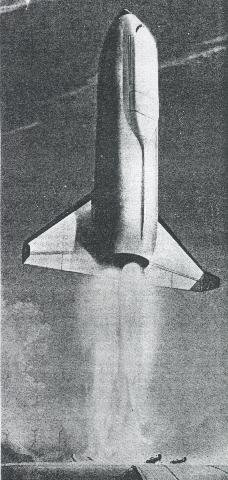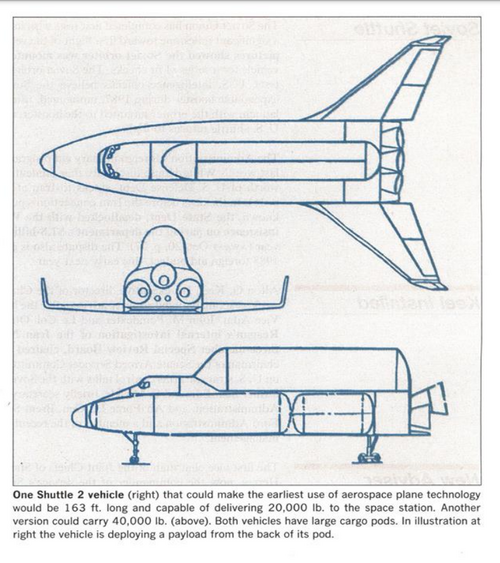You are using an out of date browser. It may not display this or other websites correctly.
You should upgrade or use an alternative browser.
You should upgrade or use an alternative browser.
US 80s TNMTS/AMLS studies aka Shuttle II
- Thread starter robunos
- Start date
archipeppe
ACCESS: Top Secret
- Joined
- 18 October 2007
- Messages
- 2,376
- Reaction score
- 2,780
- Joined
- 1 May 2007
- Messages
- 2,537
- Reaction score
- 1,752
archipeppe, archibald, thanks for the image and link, good stuff, guys, there's not a lot of info available, it seems, i tried googling, that was all i got, there are some more papers at NTRS, but they're not available as PDFs, sadly.
don't you think the orbiter looks a bit odd, with the crew compartment and payload bay perched on top of the fuel tanks?
marcus lindroo's site available again here:-
http://web.archive.org/web/20070404132502/www.abo.fi/~mlindroo/SpaceLVs/Slides/index.htm
cheers,
Robin.
don't you think the orbiter looks a bit odd, with the crew compartment and payload bay perched on top of the fuel tanks?
marcus lindroo's site available again here:-
http://web.archive.org/web/20070404132502/www.abo.fi/~mlindroo/SpaceLVs/Slides/index.htm
cheers,
Robin.
archipeppe
ACCESS: Top Secret
- Joined
- 18 October 2007
- Messages
- 2,376
- Reaction score
- 2,780
There's some additional info, I've found out in Internet (in the past years) and I used as reference for my drawing, I know is not so much but it's all I have and I share with you....
Attachments
How far along did Shuttle II get before NASA killed the effort? The design looks like it was directly inspired as a reaction the the loss of Challenger, especially the crew escape module.
While the design looks feasible, it would cost a lot of money to develop. Assuming that LC-39 would be converted for use on Shuttle-II, a lot of facilities would need to be razed and replaced. Development of two separate vehicles and methane-burning SSME would probably cost more than the original Shuttle development cost. The use of modified SSME's on the orbiter would probably have a serious impact on turnaround times, too.
The Mach 3 staging velocity would allow for booster glide back to the launch site, but it places higher delta-V demands on the orbiter. And how will the orbiter be ferried after the mission?
I'd like to know more about the metallic TPS, but I assume it's feasible due to the "fluffy" nature of the orbiter when it re-enters with empty tanks.
While the design looks feasible, it would cost a lot of money to develop. Assuming that LC-39 would be converted for use on Shuttle-II, a lot of facilities would need to be razed and replaced. Development of two separate vehicles and methane-burning SSME would probably cost more than the original Shuttle development cost. The use of modified SSME's on the orbiter would probably have a serious impact on turnaround times, too.
The Mach 3 staging velocity would allow for booster glide back to the launch site, but it places higher delta-V demands on the orbiter. And how will the orbiter be ferried after the mission?
I'd like to know more about the metallic TPS, but I assume it's feasible due to the "fluffy" nature of the orbiter when it re-enters with empty tanks.
archipeppe
ACCESS: Top Secret
- Joined
- 18 October 2007
- Messages
- 2,376
- Reaction score
- 2,780
Today it's difficult to give, at least by my side, a full answer to CFE's questions.
I know that the project was started some times before the Challenger's accident, I suppose in 1985 or so on (I think that only Scott could give a full answer to that), and it still difficult to give a full figure for cost extimation.
For sure it imply a lot of new technologies but not so much than required by the contemporary X30 NASP, or by the following X33/Venturestar, of course it required some edges technologies but nothing that wouldn't be achievable, even in the '90s.
By configurative point of view the project seems to recover the initial TSTO concept done for Shuttle in the early '70s, perhaps because (at least after 5 years of real Shuttle operations) NASA become aware of the limits and the mistaken of the original STS.
Personally I think that Shuttle II is a truly "lost occasion" to achieve a real TSTO system and, perhaps, to avoid the Columbia accident. It is not possible (and even not correct) to do the history with "if", but if this system would be developed at that time, now we can have Shuttle fully replaced by it at the very turn of the century, with ISS programme on schedule and no problem for Shuttle replacement as we face today (sorry but I don't consider Orion a replacement of the Shuttle, despite NASA official statements.....).
I know that the project was started some times before the Challenger's accident, I suppose in 1985 or so on (I think that only Scott could give a full answer to that), and it still difficult to give a full figure for cost extimation.
For sure it imply a lot of new technologies but not so much than required by the contemporary X30 NASP, or by the following X33/Venturestar, of course it required some edges technologies but nothing that wouldn't be achievable, even in the '90s.
By configurative point of view the project seems to recover the initial TSTO concept done for Shuttle in the early '70s, perhaps because (at least after 5 years of real Shuttle operations) NASA become aware of the limits and the mistaken of the original STS.
Personally I think that Shuttle II is a truly "lost occasion" to achieve a real TSTO system and, perhaps, to avoid the Columbia accident. It is not possible (and even not correct) to do the history with "if", but if this system would be developed at that time, now we can have Shuttle fully replaced by it at the very turn of the century, with ISS programme on schedule and no problem for Shuttle replacement as we face today (sorry but I don't consider Orion a replacement of the Shuttle, despite NASA official statements.....).
archipeppe said:Today it's difficult to give, at least by my side, a full answer to CFE's questions.
For sure it imply a lot of new technologies but not so much than required by the contemporary X30 NASP, or by the following X33/Venturestar, of course it required some edges technologies but nothing that wouldn't be achievable, even in the '90s.
It does have a lot of X-33 similarities. External payload fairing (seen in later VentureStar renderings,) metallic TPS, and multi-lobed tanks. The difference is that Shuttle II's engineers were realistic about the feasibility of SSTO, and weren't as optimistic about aerospikes and composite multi-lobed tanks.
First, thank you 1.0000000 times for the link on Lindroos website.
... Correcting two big difficulties found in the 1970 TSTO concept = it is not manned, and the flyback is shorter thanks to lower stagging velocity.
Are big, empty tanks a drawback or a benefit for reentry ?
By configurative point of view the project seems to recover the initial TSTO concept done for Shuttle in the early '70s
... Correcting two big difficulties found in the 1970 TSTO concept = it is not manned, and the flyback is shorter thanks to lower stagging velocity.
Are big, empty tanks a drawback or a benefit for reentry ?
archipeppe
ACCESS: Top Secret
- Joined
- 18 October 2007
- Messages
- 2,376
- Reaction score
- 2,780
Archibald said:Are big, empty tanks a drawback or a benefit for reentry ?
By my side I think that are not a real benefit, because even empty they still mantain their volume and this volume you have to protect in any case (filled or not) with appropriate TPS, which are "dead" weight until re-entry.
Is more like a due you must to pay to ensure a full TSTO....
- Joined
- 1 April 2006
- Messages
- 11,053
- Reaction score
- 8,511
Following are illustrations from various AMLS-related papers showing various configurations studied. Year in filename makes a mark of publication date.
Attachments
- Joined
- 1 April 2006
- Messages
- 11,053
- Reaction score
- 8,511
More..
Attachments
- Joined
- 1 April 2006
- Messages
- 11,053
- Reaction score
- 8,511
- Joined
- 1 April 2006
- Messages
- 11,053
- Reaction score
- 8,511
- Joined
- 1 May 2007
- Messages
- 2,537
- Reaction score
- 1,752
thanks flateric, didn't realise the configurations studied were so far ranging, like the 'HOTOl-a-like'.
isn't the 'conical accelerator' AMLS, similar to some of the images posted in the NASP thread?,
were the AMLS studies in-house to NASA, or was the aerospace industry involved, if so, do we have any ideas as to which contractors?
cheers,
Robin.
isn't the 'conical accelerator' AMLS, similar to some of the images posted in the NASP thread?,
were the AMLS studies in-house to NASA, or was the aerospace industry involved, if so, do we have any ideas as to which contractors?
cheers,
Robin.
archipeppe
ACCESS: Top Secret
- Joined
- 18 October 2007
- Messages
- 2,376
- Reaction score
- 2,780
Many, many thanks Flateric for this incredibly detalied material.
For sure I will make a good use of these new references......
For sure I will make a good use of these new references......
- Joined
- 1 April 2006
- Messages
- 11,053
- Reaction score
- 8,511
robunos said:thanks flateric, didn't realise the configurations studied were so far ranging, like the 'HOTOl-a-like'.
isn't the 'conical accelerator' AMLS, similar to some of the images posted in the NASP thread?,
were the AMLS studies in-house to NASA, or was the aerospace industry involved, if so, do we have any ideas as to which contractors?
cheers,
Robin.
'Conical accelerator' is a palliative for Boeing NASP, at least I was always thinking so. There are another paper where three early NASP designs including this are pictured together - with others being duPont 'government baseline' and the other with podded scramjets - presumably Lockheed design.
I will check for contractors references regarding involvment, I presume Rockwell as a must. There are more designs offered for AMLS by NASA in cooperation with universities. Will post more soon.
- Joined
- 1 April 2006
- Messages
- 11,053
- Reaction score
- 8,511
shutle II concept by john frassinito and associates souce the dream machines by ron miller. i gues it is an outside consuting firm for nasa other cocepts in the book also give same company name most look prety outlandish.
- Joined
- 29 September 2006
- Messages
- 1,700
- Reaction score
- 1,182
pometablava said:Thanks a lot.
Just another question, that four attached bodies are boosters?
Just look like tanks to me. Given that they've gone to all the trouble to detail the rocket engines on the Shuttle, it'd be odd not to show 'em on attached boosters.
- Joined
- 13 August 2007
- Messages
- 7,880
- Reaction score
- 9,007
pometablava said:Found this pic on a Spanish "popular tech" magazine from the 80's. It is labeled as Shuttle II project. Any idea about its true identity?
here more Information on this proposal
http://beyondapollo.blogspot.com/2011/04/jscs-shuttle-ii-1988.html
President Ronald Reagan had signed a Directive in 1985 ordering that NASA begin work to replace the Shuttle.
The NASA Headquarters Office of Space Transportation directed the 1988-1989 Shuttle II effort,
with the lion's-share of design work taking place in Hampton, Virginia, at NASA Langley Research Center (LaRC)
Not all Shuttle II work took place at LaRC, however. The Advanced Programs Office at NASA Johnson Space Center (JSC) in Houston, Texas
Design for payload of 10 tons or 11 Astronauts to a US Space Station
it burn liquid hydrogen fuel, liquid hydrocarbon (kerosene or propane) fuel with liquid oxygen
the oxygene is stored inside wing tanks, the fuel in four external Tanks. (in red)
launch mass is 550 tons, with empty mass of 50 to 75 tons
powerd by second generation SSME
one STME with extend telescoping exhaust nozzle
two STBE with high thrust buring hydrocarbon, who dropt with there Tanks
for orbit are twin OMS engines, who are derivative of the RL-10 engine
the cargobay has a unique way to open no doors like STS
but hinge the tail section downward.
for safety JSC Shuttle II has a full Escape system
the cockpit can seperate from rest
be a Spaceship in orbit and would land like Dynasoar
Attachments
Model of Johnson Space Center (JSC) Space Shuttle II design circa 1988.
Source:
http://beyondapollo.blogspot.com/2011/04/jscs-shuttle-ii-1988.html
Source:
http://beyondapollo.blogspot.com/2011/04/jscs-shuttle-ii-1988.html
Attachments
Space Shuttle II design concepts illustrated by Mark Dowman of John Frassanito & Associates.
According to an e-mail message that Mark Dowman sent me:
Source:
http://forum.nasaspaceflight.com/index.php?topic=6348.msg105942#msg105942
According to an e-mail message that Mark Dowman sent me:
I worked with Frassanito, from '89 to '92. He already had the contract with NASA's advance programs office, when I came onboard. During that time, our team did hundreds (thousands?) of designs for advanced shuttles.
We focused on alternate propulsion options, more robust cargo capabilities, and enhanced safety for the crew. Some were "Shuttle C" style, the unmanned cargo shuttle, others had detachable flyback crew cabins, still others were inline multi-booster cargo configurations, more like an Energia.
Since none of them got further then the drawing board, we didn't get to see if they would replace or supplement, the existing fleet.
Source:
http://forum.nasaspaceflight.com/index.php?topic=6348.msg105942#msg105942
Attachments
- Joined
- 13 August 2007
- Messages
- 7,880
- Reaction score
- 9,007
Orionblamblam said:Archibald said:I'm not sure Armageddon (Armoire a guidon ?) qualifies as a movie.
Hey, if "An Inconvenient Truth" qualifies as a Nobel prize winning documentary, then "Armageddon" is the pinnacle of high literature.
this deep analyse show: "Armageddon" is not a movie... ;D
back to Shuttle II studies
Why those alternative JSC study to the other Study ?
- Joined
- 9 October 2009
- Messages
- 21,147
- Reaction score
- 12,249
A Wired.com article (Beyond Apollo blog) on JSC's 1988 Shuttle II proposal. Also mentions JSC's earlier Evolved Shuttle (see image below) and the better known Shuttle II proposal from Langley Research Center.

[IMAGE CREDIT: NASA/Wired.com]
Engineers in Houston envisioned that their Shuttle II might develop from an Evolved Space Shuttle. In the Evolved Shuttle, Liquid Replacement Boosters would have stood in for the Space Shuttle’s Solid Rocket Boosters, though the Evolved Shuttle would have retained the Space Shuttle’s expendable External Tank and, with minor modifications, the Space Shuttle Main Engines (SSMEs). Winglets on the tips of the Evolved Shuttle’s modified delta wings would have replaced the Space Shuttle’s single vertical tail fin. Redesigned Orbital Maneuvering System (OMS) engines based on the venerable RL-10 engine would have drawn liquid hydrogen/liquid oxygen propellants from tanks in the wings.
The most dramatic change, however, was reserved for the crew compartment. It would have been completely redesigned so that it could separate from the rest of the Evolved Shuttle in the event of a catastrophic failure and operate as an independent small piloted spacecraft. This feature, along with the wing configuration, would carry over to JSC’s Shuttle II design.
NASA JSC engineers gave no indication of when they expected the transition from Space Shuttle to Evolved Shuttle would occur. If one assumes, however, that JSC’s Shuttle II would have become operational in the first years of the 21st century – like LaRC’s Shuttle II – then the Evolved Shuttle would probably have flown during the 1990s.
For convenience, here's a crosslink to the old Shuttle II thread.
- Joined
- 27 December 2005
- Messages
- 16,924
- Reaction score
- 21,797
Moved a whole bunch of not-entirely civil discussion on RLV design to https://www.secretprojects.co.uk/threads/rlv-design-discussion.38044/
This topic is to discuss 1980s Shuttle successor projects.
This topic is to discuss 1980s Shuttle successor projects.
Recently bought a lot of Shuttle II and vaguely related stuff off ebay. Waiting for it to arrive; should be here by about Feb 8, 2022. It was ridiculously expensive, but the purchase was crowdfunded: funders will receive a full set of high-rez color scans. Enough funders so far that the per-funder price is $15, with more funders price will drop. If interested, email me. Price will be set and signups closed when the items arrive.

http://www.aerospaceprojectsreview.com/blog/?p=4802


http://www.aerospaceprojectsreview.com/blog/?p=4802

Cosmic Planes
ACCESS: Restricted
- Joined
- 16 September 2010
- Messages
- 11
- Reaction score
- 27
Does anyone have more information on these pre-Challenger Next-Gen shuttle designs? The pages I found these on are very vague.
Attachments
NavarchNicias
ACCESS: Restricted
- Joined
- 23 March 2022
- Messages
- 24
- Reaction score
- 75
Does anyone have more information on these pre-Challenger Next-Gen shuttle designs? The pages I found these on are very vague.
I think this qualifies? Pretty close at least.
Attachments
martinbayer
ACCESS: Top Secret
- Joined
- 6 January 2009
- Messages
- 2,903
- Reaction score
- 3,001
I was there when SLI began in 2000, see https://en.wikipedia.org/wiki/Space_Launch_Initiative, so take it from me that there was/is no direct heritage/connection to any Boeing "US 80s TNMTS/AMLS studies aka Shuttle II", as implied in the title of this thread, although as usual quite some rediscovering/reinventing/inspiration may have occurred.There was the Boeing Bimese of SLI
Similar threads
-
Bell Textron Air Cushion Landing System (ACLS) for space vehicles
- Started by flateric
- Replies: 12
-
-
-
By solids to the Moon: all-solid JPL Nova proposal
- Started by Skybolt
- Replies: 38
-
Candidate Space Shuttle Orbiters Wind Tunnel Studies 1969 NASA Langley Research
- Started by sferrin
- Replies: 2



